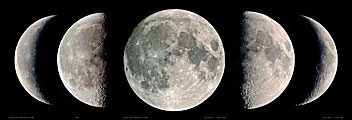Definitions for Calendars of Astronomical Events
Definitions
Below is a brief list of definitions for astronomical terms used in the Calendars of Astronomical Events.
- Perihelion - the instant when a planet is closest to the Sun
- Aphelion - the instant when a planet is furthest from the Sun
- Perigee - the instant when the Moon is closest to Earth
- Apogee - the instant when the Moon is furthest from Earth
- Inferior Conjunction - the instant when a planet passes between Earth and the Sun (Mercury or Venus)
- Superior Conjunction - the instant when a planet passes on the opposite side of the Sun from Earth (Mercury or Venus)
- Greatest Elongation - the apparent angle between a planet and the Sun seen from Earth; during eastern elongation (E), the planet appears as an evening star; during western elongation (W), the planet appears as a morning star
- Opposition - the instant when a planet appears opposite the Sun as seen from Earth
- Conjunction - the instant when a planet appears closest the Sun as seen from Earth
- Occultation - the Moon occults or eclipses a star or planet
- Ascending Node - the point where a planet crosses from the southern to northern portion of its orbit
- Descending Node - the point where a planet crosses from the northern to the southern portion of its orbit
Time Zones and Astronomical Events
Astronomical events are usually presented in Greenwich Mean Time (GMT) or, more technically accurate, Universal Time (UT). In order to convert such predictions from GMT (i.e., UT) to local time, you must know your time zone. The conversion from UT to local time for time zones throughout North America are as follows:
Atlantic Standard Time (AST) = UT - 4 hours
Eastern Standard Time (EST) = UT - 5 hours
Central Standard Time (CST) = UT - 6 hours
Mountain Standard Time (MST) = UT - 7 hours
Pacific Standard Time (PST) = UT - 8 hours
Alaskan Standard Time (AKST) = UT - 9 hours
Hawaiian Standard Time (HST) = UT - 10 hours
If Daylight Saving Time is in effect in the time zone, you must ADD one hour to the standard time.
For example, let's assume that an eclipse begins in Toledo, Ohio on June 20 at 20:25 UT. Toledo is in the Eastern Standard Time zone, so:
Local Time = 20:25 - 5 hours
= 15:25 (= 3:25 pm)
But since Toledo observes Daylight Saving Time in June, we must ADD one more hour to the standard time.
So the local time in Toledo is 16:25 (=4:25pm).
For more information, see Time Zones.
Astronomical Calendars for Various Years and Time Zones
The table below contains links to astronomical events calendars for a range of years and Time Zones. Abbreviations for the time zones are: GMT = Greenwich Mean Time, AST = Atlantic Standard Time, EST = Eastern Standard Time, CST = Central Standard Time, MST = Mountain Standard Time, PST = Pacific Standard Time, AKST = Alaskan Standard Time, and HST = Hawaiian Standard Time.
| Calendar of Astronomical Events | |||||||||||||||
| GMT | 2011 | 2012 | 2013 | 2014 | 2015 | 2016 | 2017 | 2018 | 2019 | 2020 | 2021 | 2022 | 2023 | 2024 | 2025 |
| AST | 2011 | 2012 | 2013 | 2014 | 2015 | 2016 | 2017 | 2018 | 2019 | 2020 | 2021 | 2022 | 2023 | 2024 | 2025 |
| EST | 2011 | 2012 | 2013 | 2014 | 2015 | 2016 | 2017 | 2018 | 2019 | 2020 | 2021 | 2022 | 2023 | 2024 | 2025 |
| CST | 2011 | 2012 | 2013 | 2014 | 2015 | 2016 | 2017 | 2018 | 2019 | 2020 | 2021 | 2022 | 2023 | 2024 | 2025 |
| MST | 2011 | 2012 | 2013 | 2014 | 2015 | 2016 | 2017 | 2018 | 2019 | 2020 | 2021 | 2022 | 2023 | 2024 | 2025 |
| PST | 2011 | 2012 | 2013 | 2014 | 2015 | 2016 | 2017 | 2018 | 2019 | 2020 | 2021 | 2022 | 2023 | 2024 | 2025 |
| AKST | 2011 | 2012 | 2013 | 2014 | 2015 | 2016 | 2017 | 2018 | 2019 | 2020 | 2021 | 2022 | 2023 | 2024 | 2025 |
| HST | 2011 | 2012 | 2013 | 2014 | 2015 | 2016 | 2017 | 2018 | 2019 | 2020 | 2021 | 2022 | 2023 | 2024 | 2025 |
For years or time zones not covered above, please visit SKYCAL the astronomical events calendar generator.

Phases of the Moon: 2001 to 2100
The table below contains links to 100-year tables of Moon phases for a number of time zones. Abbreviations for the time zones are: GMT = Greenwich Mean Time, EST = Eastern Standard Time, CST = Central Standard Time, MST = Mountain Standard Time, PST = Pacific Standard Time.
| Phases of the Moon: 2001 to 2100 |
|||||||||
| GMT | EST | CST | MST | PST | |||||
Phases of the Moon Photo Gallery is an image collection showing the Moon's phases over a complete synodic month.
An eclipse of the Sun can only occur at New Moon (see: Solar Eclipses for Beginners), while an eclipse of the Moon can only occur at Full Moon (see: Lunar Eclipses for Beginners). In any calendar year there are a minimum of two solar and two lunar eclipses.